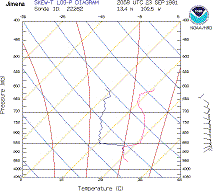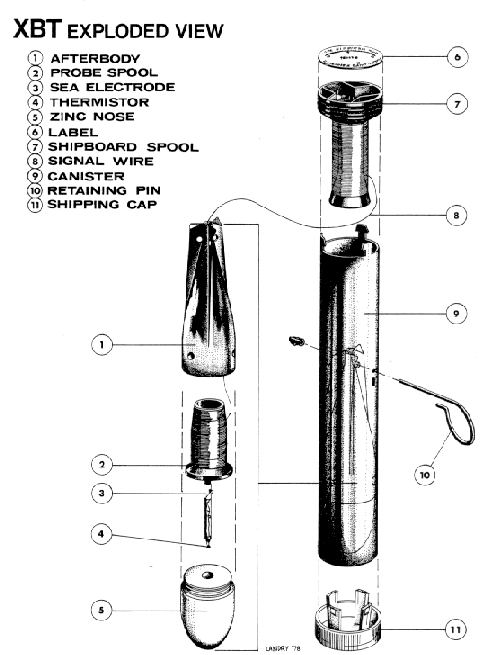 |
Aircraft Expendables |
 |
- Dropwindsondes
Dropwindsondes are deployed from the aircraft and drift
down on a parachute measuring vertical profiles of pressure,
temperature, humidity and wind as they fall. They are released
from the both the WP-3D and G-IV aircraft over data-sparse oceanic
regions. From 1982 until 1997, HRD used Omega dropwindsondes (ODWs)
that employed the very low frequency Omega navigation signals to
estimate the sondes motion relative to the aircraft, and subsequently
calculate the wind. NOAA now uses new sondes that employ the more
accurate GPS navigation to estimate winds.
A deployed sonde and chute

|

Example: Eye sounding in Hurricane Jimena (1993)
|
- Airborne eXpendable BathyThermographs (AXBT)
- Airborne eXpendable Current Profilers (AXCP)
- Airborne eXpendable Conductivity Temperature and Depth probes (AXCTD)
- Drifting buoys
Oceanographic instruments may be deployed from the WP-3D aircraft
either from external chutes using explosive cads or from an internal
drop chute. They activate upon hitting the ocean surface and radio
sea temperature, salinity, and current information back to computers
aboard the aircraft.

Exploded view of an AXBT
References
- Aberson, S.D. 2002 "Two years of operational hurricane synoptic surveillance." Weather and Forecasting, 17(5) pp.1101-1110
- Rogers, R.F., S.D. Aberson, J. Kaplan, and S.B. Goldenberg. 2002 "A pronounced upper-tropospheric warm anomaly encountered by the NOAA Gulfstream-IV aircraft in the vicinity of deep convection." Monthly Weather Review, 130(1) pp.180-187
- Aberson, S.D., and J.L. Franklin. 1999 "Impact on hurricane track and intensity forecasts of GPS dropwindsonde observations from the first-season flights of the NOAA Gulfstream-IV jet aircraft." Bulletin of the American Meteorological Society, 80(3) pp.421-428
- Burpee, R.W., J.L. Franklin, S.J. Lord, R.E. Tuleya, and S.D. Aberson. 1996 "The impact of Omega dropwindsondes on operational hurricane track forecast models." Bulletin of the American Meteorological Society, 77(5) pp.925-933
- Franklin, J.L., S.E. Feuer, J. Kaplan, and S.D. Aberson. 1996 "Tropical cyclone motion and surrounding flow relationships: Searching for beta gyres in Omega dropwindsonde datasets." Monthly Weather Review, 124(1) pp.64-84
- Burpee, R.W., S.D. Aberson, P.G. Black, M. DeMaria, J.L. Franklin, J.S. Griffin, S.H. Houston, J. Kaplan, S.J. Lord, F.D. Marks, M.D. Powell, and H.E. Willoughby. 1994 "Real-time guidance provided by NOAA's Hurricane Research Division to forecasters during Emily of 1993." Bulletin of the American Meteorological Society, 75(10) pp.1765-1783
- Franklin, J., S. Lord, and F. Marks, 1988 "Dropwindsonde and radar observations of the eye of Hurricane Gloria (1985)." Mon. Wea. Rev., 116, pp.1237-1244.
Contact information on Dropwindsondes mail to :
Sim.Aberson@noaa.gov,
Contact information on AXBTS and buoys mail to :
Pete.Black@noaa.gov
Return to aircraft page.
Return to HRD page.
Updated June 16, 2003
![[Horizontal Rule]](graphics/hr.gif) |
|
![[OAR/DOC/NOAA Logos]](oar_noaa_doc_logos3.jpg)
|
 |
|
![[Atlantic Oceanographic and Meteorological Laboratory]](hrd_top_logo7.jpg)













![[OAR/DOC/NOAA Logos]](oar_noaa_doc_logos3.jpg)